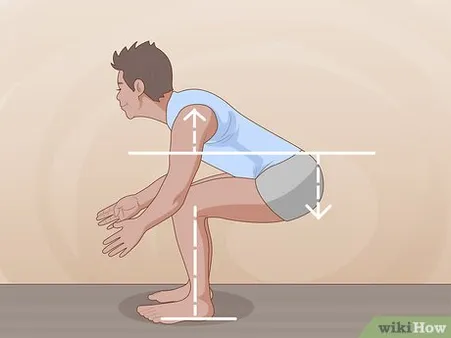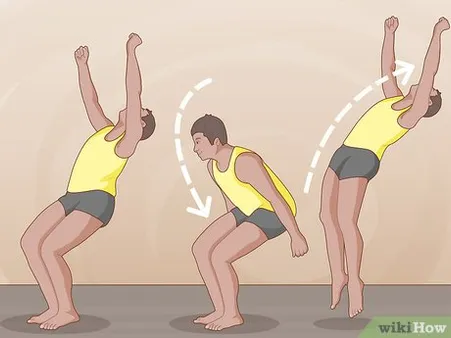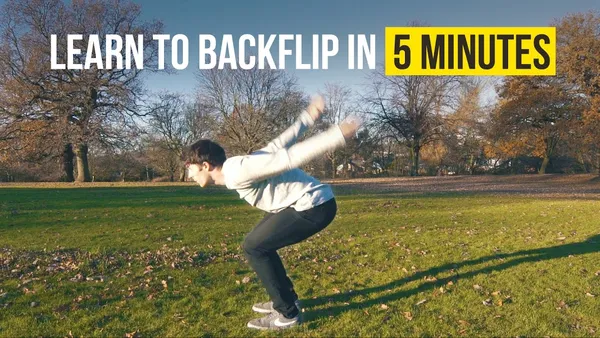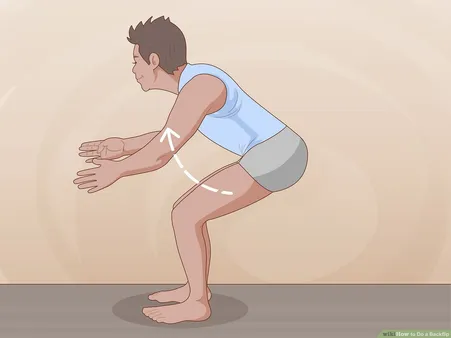Table of Contents
Welcome to Kizworld's guide to mastering the art of backflips! Whether you're a seasoned athlete or just starting your fitness journey, our comprehensive guide will take you through the steps of How to do a backflip safely and effectively. With our tips and techniques, you'll learn the basics, overcome common mistakes, and explore advanced variations to elevate your skills to new heights.
How to Do a Backflip: A Step-by-Step Guide for Beginners
I. Master the Art of Backflips: A Comprehensive Guide
Master the Art of Backflips: A Comprehensive Guide
Stance and Posture
A proper stance and posture are crucial for executing a successful backflip. Stand with your feet shoulder-width apart, knees slightly bent, and your back straight. Your arms should be relaxed at your sides. Engage your core muscles to stabilize your body and maintain balance.
- Related Post: How to Do a Handstand
- Related Post: The Benefits of Gymnastics for Kids
Jumping into the Backflip
To initiate the backflip, start by jumping straight up into the air. As you jump, tuck your knees towards your chest and bring your arms up to your sides. Keep your head tucked in and your eyes focused on the ground in front of you.
- Related Post: How to Do a Cartwheel
- Related Post: How to Do a Split
Tucking and Rotating
As you reach the peak of your jump, tuck your body into a tight ball. Bring your knees to your chest and wrap your arms around your shins. Simultaneously, begin rotating your body backward. Keep your head tucked in and your eyes focused on the ground.
- Related Post: How to Do a Front Flip
- Related Post: How to Do a Roundoff
Landing Safely
As you complete the rotation, extend your legs and arms and land softly on your feet. Bend your knees to absorb the impact and maintain your balance. Keep your head up and your eyes focused forward.
- Related Post: How to Do a Walkover
- Related Post: How to Do a Somersault
Common Mistakes to Avoid During Backflips
To ensure a safe and successful backflip, avoid these common mistakes:
- Improper Stance and Posture: Failing to maintain a proper stance and posture can lead to loss of balance and control during the backflip.
- Incorrect Warm-Up Routine: Neglecting a proper warm-up can increase the risk of injury and hinder your performance.
- Fear and Hesitation: Overcoming fear and hesitation is essential for executing a successful backflip. Trust in your abilities and commit to the move.
- Rushing Through the Steps: Taking the backflip too quickly can result in poor form and increased risk of injury. Focus on each step and maintain control throughout the movement.
Advanced Techniques and Variations of Backflips
Once you have mastered the basic backflip, you can progress to more advanced techniques and variations, such as:
- Backflip with a Twist: Add a twist to your backflip by rotating your body 180 degrees during the flip.
- Side Flip: Perform a backflip while rotating your body to the side.
- Double Backflip: Execute two consecutive backflips in a row.
Safety Precautions and Tips for Learning Backflips
To ensure a safe learning experience, follow these precautions and tips:
- Choose a Safe Environment: Practice backflips in a safe and controlled environment, such as a gymnastics gym or a padded mat.
- Supervision and Guidance: Seek guidance from a qualified gymnastics coach or instructor to ensure proper technique and minimize the risk of injury.
- Build Fitness Foundation: Develop a strong fitness foundation by focusing on exercises that improve your strength, flexibility, and coordination.
Final Tips for Mastering the Backflip
To master the backflip, keep these tips in mind:
- Practice Regularly: Consistent practice is key to improving your skills and gaining confidence in performing backflips.
- Focus on Technique: Pay attention to your form and technique to ensure you are executing the backflip correctly and safely.
- Stay Patient: Mastering the backflip takes time and patience. Don't get discouraged if you don't see immediate results. Keep practicing and you will eventually achieve your goal.
II. Laying the Foundation: Building Strength and Flexibility
Laying the Foundation: Building Strength and Flexibility
Mastering the Basics of Backflips
Before attempting a backflip, it's crucial to establish a solid foundation of strength and flexibility. This will not only enhance your performance but also minimize the risk of injuries. Here are some key areas to focus on:
- Core Strength: A strong core is essential for maintaining stability and control during the backflip. Engage in exercises that target your abdominal and back muscles, such as planks, sit-ups, and crunches.
- Leg Strength: Powerful legs provide the necessary propulsion for a successful backflip. Incorporate exercises like squats, lunges, and calf raises into your routine to strengthen your lower body.
- Flexibility: Adequate flexibility allows you to execute the backflip with proper form and reduce the strain on your muscles. Stretch your hamstrings, quadriceps, and shoulders regularly to improve your range of motion.
By consistently working on these aspects, you'll build a strong and flexible foundation that will support your backflip journey.
How to Do a Handstand: A Step-by-Step Guide for Beginners
Warming Up and Preparing Your Body
Before attempting a backflip, it's essential to warm up your body properly. This helps increase your heart rate, blood flow, and muscle temperature, reducing the risk of injuries. Here's a simple warm-up routine:
- Light Cardio: Start with 5-10 minutes of light cardio, such as jogging or jumping jacks, to elevate your heart rate.
- Dynamic Stretching: Perform dynamic stretches that involve active movements, such as leg swings, arm circles, and torso twists.
- Specific Exercises: Include exercises that target the muscles used in backflips, such as leg raises, hip flexor stretches, and shoulder rolls.
By following this warm-up routine, you'll prepare your body for the demands of backflips and minimize the risk of injuries.
The Benefits of Gymnastics for Kids: Building Strength, Flexibility, and Confidence
III. Perfecting the Technique: Step-by-Step Guide to Backflips
Perfecting the Technique: Step-by-Step Guide to Backflips
Stance and Posture
Begin with a strong and stable stance, feet shoulder-width apart and knees slightly bent. Keep your back straight and core engaged to maintain proper posture throughout the flip.
Pro Tip: Practice standing on one leg to improve your balance and stability, essential for successful backflips.
- Related Post: How to Improve Your Balance and Coordination with Gymnastics
- Related Post: The Best Gymnastics Exercises for Core Strength
Jumping into the Backflip
Generate power by swinging your arms upward and simultaneously jumping into the air. Extend your legs fully and reach your arms overhead to create a vertical position.
Remember: The higher you jump, the more time you'll have to complete the backflip safely.
Common Mistake | Correction |
|---|---|
Jumping too low | Increase your vertical jump by practicing exercises like box jumps and squat jumps. |
Leaning forward or backward | Maintain a straight body line and keep your core engaged to prevent leaning. |
Tucking and Rotating
As you reach the peak of your jump, tuck your knees towards your chest and bring your arms close to your body. Initiate the rotation by tucking your chin to your chest and simultaneously pushing your hips forward.
Key Point: Keep your body tight and compact throughout the tuck and rotation to maintain control.
- Related Post: How to Master the Basic Gymnastics Skills
- Related Post: The Best Gymnastics Drills and Exercises
Landing Safely
As you complete the rotation, extend your legs and arms to prepare for landing. Bend your knees and absorb the impact by landing softly on the balls of your feet.
Safety First: Always practice backflips on a soft surface like a gymnastics mat or a thick foam pit to minimize the risk of injury.
IV. Conquering Fear and Overcoming Mental Barriers
Conquering Fear and Overcoming Mental Barriers
Fear is a natural response to danger, but it can also be a hindrance when it comes to learning new skills or pushing yourself out of your comfort zone. When it comes to learning how to do a backflip, fear is a common obstacle that many people face. Whether you're afraid of falling, getting injured, or simply not being able to do it, fear can hold you back from achieving your goal.
If you're struggling with fear, there are a few things you can do to overcome it. First, it's important to understand that fear is normal. Everyone experiences fear at some point in their lives. The key is to not let fear control you. Instead, you need to learn how to manage it.
One way to manage fear is to break it down into smaller, more manageable pieces. For example, if you're afraid of falling, you can start by practicing backflips on a trampoline or into a foam pit. This will help you to get used to the feeling of being upside down and spinning through the air. As you progress, you can gradually increase the difficulty of your practice until you're able to do a backflip on the ground.
Another way to overcome fear is to focus on your breathing. When you're feeling scared, your breathing becomes shallow and rapid. This can make you feel even more anxious and panicked. To calm yourself down, focus on taking slow, deep breaths. This will help to slow your heart rate and relax your body.
Finally, it's important to remember that you're not alone. There are many people who have overcome their fear of doing a backflip. If they can do it, so can you. Just keep practicing and don't give up on your goal.
Tip | Description |
|---|---|
Break down your fear into smaller, more manageable pieces. | Start by practicing backflips on a trampoline or into a foam pit. |
Focus on your breathing. | Take slow, deep breaths to calm yourself down. |
Remember that you're not alone. | Many people have overcome their fear of doing a backflip. |
With a little practice and perseverance, you can overcome your fear and learn how to do a backflip. Just remember to take it slow, focus on your breathing, and don't give up on your goal.
Once you've conquered your fear and learned how to do a backflip, you'll be amazed at how much your confidence and self-esteem have grown. You'll also be able to enjoy the thrill of performing this exciting and challenging skill.
So what are you waiting for? Start practicing today and see how far you can go.
Here are some additional tips for conquering fear and overcoming mental barriers:
- Talk to a friend, family member, or therapist about your fears.
- Visualize yourself successfully performing the skill that you're afraid of.
- Set small, achievable goals for yourself and gradually work your way up to bigger goals.
- Don't be afraid to ask for help from a qualified instructor or coach.
- Remember that everyone experiences fear at some point in their lives. The key is to not let fear control you.
With a little effort and perseverance, you can overcome your fears and achieve your goals.
So don't let fear hold you back. Go out there and start living your life to the fullest.
You can also check out our article on How to Improve Your Flexibility and Mobility with Gymnastics for more tips on how to overcome fear and achieve your goals.
V. Conclusion
As you progress in your backflip journey, remember that practice makes perfect. Consistency and dedication will help you overcome challenges and achieve your goals. Stay patient, listen to your body, and never compromise safety. With perseverance and the right mindset, you'll be flipping like a pro in no time. Embrace the thrill of backflips and unlock your full potential as an athlete. The world of flips and aerial maneuvers awaits you – take the leap and soar high!